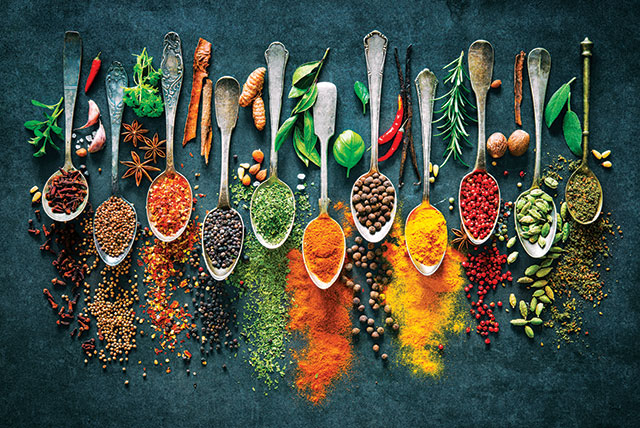
By Linda Scotti, RN, BSN, MA
I’ve always been interested in nature and plants. Scientists estimate that there are more than 5,000 phytochemicals (naturally occurring plant chemicals). These phytochemicals not only protect the plant from pathogens and cell damage, but they also help us when we ingest the plant. Herbs and spices contain high levels of these phytochemicals which are powerful antioxidants that improve digestion, reduce inflammation, support the immune system and are antimicrobial.
More than 2,000 years ago, the Hippocratic school of medicine proclaimed, “Let food be thy medicine, and medicine be thy food.” Fortunately, this sage advice is coming back these days as more and more people are demanding local, organic, nutrient-rich food. Plant-based whole foods are gaining in popularity. Embracing a cuisine rich in spices, as well as fruits and vegetables, is not only much more flavorful but also health-promoting and disease-preventive. Herbs and spices not only add more flavor to our foods but also add concentrated nutrients for our health and well-being. Our ancestors have known this for thousands of years. We only need to look at cookbooks from other cultures around the world to see how they’ve used the local herbs and spices in their food.
Many of the chronic diseases today start in the gut with poor digestion. Digestive spices like ginger, coriander, cumin, fennel and cardamom should be added to everyone’s daily diet. Clove, oregano, thyme, cinnamon and cumin are now being studied as additives to prevent spoilage in packaged foods because of their high levels of antibacterial and antifungal properties. Why not put them in our food?
The Mediterranean diet has long been known for its health-promoting properties. Look at the herbs they use—thyme, rosemary, oregano, sage, lavender, etc. India has a very low incidence of dementia, primarily attributed to their daily dose of turmeric with its powerful curcumin pigment that gives it that bright yellow color. We can learn quite a bit from these cultures.
When I visited Istanbul, the food was so flavorful and alive! My mouth still waters remembering the olives with fresh herbs that I ate for breakfast daily. Recently, on one of my frequent visits to Mexico City, I had oyster mushrooms with mole sauce at a vegan restaurant. The mole was purely vegan and made from scratch! The flavors danced in my mouth with each bite. I had never experienced those flavors in food before—an orchestra of flavors—the various chilies, the dried fruits, the nuts, the spices, and then, the dark chocolate. It was so amazing I purchased two bags of mole paste at a local vegan market to take home!
The key to receiving benefits from these herbs and spices is to use the freshest and highest quality herbs and spices available. If possible, it’s best to buy the whole spice (seeds, barks, berries, etc.) in small quantities and grind them fresh as you use them. An inexpensive coffee grinder works great. This is especially important for herbal teas and infusions. Nowadays, there are many small organic farms that you can buy from directly.
Please note, when I speak about using or ingesting herbs and spices, I am talking about cooking with herbs and spices—and using them in teas and infusions—not taking them in a pill form. Consult with a certified herbalist or your doctor when considering taking anything in a concentrated form.
These are some of the spices that I use daily:
Turmeric: Known as “Indian gold” and “guardian of the liver,” turmeric is beyond amazing, a must for everyone to take daily. As it’s very potent, you only need one-quarter teaspoon per day to reap its immune boosting benefits. Always take it with a pinch of black pepper for better absorption. Cooking it in oil also aids in absorption. It’s available in powder or the fresh root. Its benefits are extensive—anti-inflammatory, analgesic, hemostatic (stops bleeding), blood purifier, and a powerful antioxidant—a cancer fighter. More than a thousand studies have shown the many cancer-fighting properties and DNA protection of curcumin, the active pigment that gives it that yellow color.
Black Pepper: Known as the “King of Spices,” black pepper potentiates the bioavailability of turmeric as much as 2,000 percent! It also increases the bioavailability of other herbs.
Coriander seeds: One of the oldest spices, dating back to 7000 B.C., coriander seeds have powerful cell-protecting antioxidants that soothe digestive ailments.
Cumin seeds: Another super digestive spice, cumin is the most popular spice in Mexican cuisine. Its volatile oils come alive in Indian cooking as the seeds are put to heat and that nutty aroma fills the kitchen. Cumin is full of vitamins and minerals, including iron. It also is about one percent salicylic acid which contributes to its anti-inflammatory properties.
Fennel: Fennel has it all: it’s a vegetable, an herb and a spice. The seeds have potent aromatic qualities, and help to relieve digestive problems, muscle tension and pain as it’s also a powerful anti-inflammatory.
Ginger: I can’t imagine food without ginger. Ginger is a proven remedy for nausea, motion sickness, as well as a powerful anti-inflammatory shown to decrease joint pain. If you eat a small piece of fresh ginger before your meal, it stimulates the digestive fire-releasing enzymes for better assimilation of nutrients.
Cardamom: I’m in love with cardamom with its enticing flavor and aroma! Known as the “Queen of Spices” for its special medicinal and culinary values, cardamom has powerful anti-inflammatory and anti-spasmodic qualities that improve digestion. The best cardamom comes from the rainforests of Southern India where it is harvested by hand. Its sweet flavor activates comfort and a positive feeling about life.
Linda Scotti, RN, BSN, MA presents classes at the Science of Spirituality International Meditation Center in Lisle, Illinois. She has been working in the health-care field for over 40 years. Having lived and traveled all over the world, she and her husband have explored the foods, herbs and spices of Japan, Mexico, India, and many countries in South America. She says that the healing properties of herbs and spices are safe and effective when used in the kitchen to create delicious meals and aromatic teas and infusions.
 Conscious Community Magazine Dedicated to Elevating Consciousness
Conscious Community Magazine Dedicated to Elevating Consciousness




